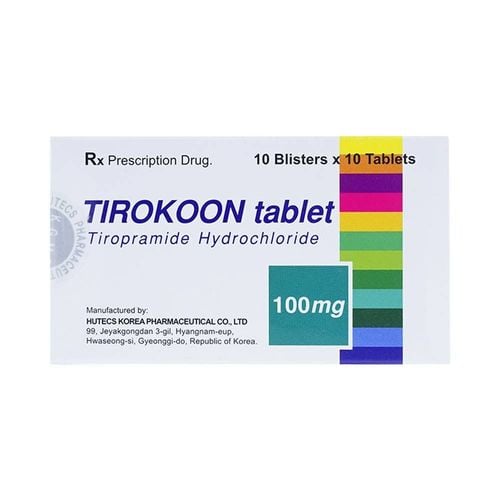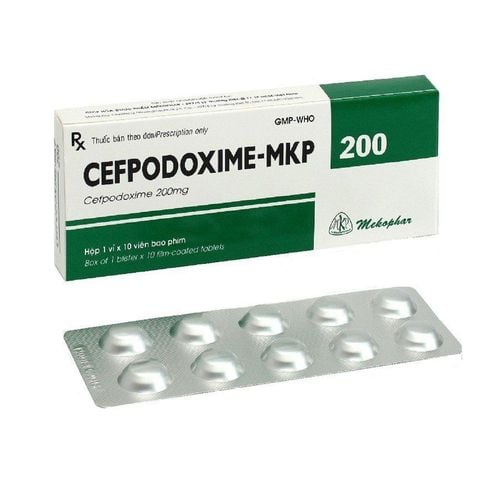This is an automatically translated article.
Gyrablock belongs to the group of antiparasitic, anti-infective, antiviral and antifungal drugs. The drug is available in the form of film-coated tablets. The main ingredient of Gyrablock is Norfloxacin, indicated in the treatment of upper/lower urinary tract infections, cystitis, pyelonephritis and urethritis. However, during treatment with Gyrablock, you may also experience side effects such as: Digestive disturbances, loss of appetite, anxiety and restlessness...
1. The mechanism of action of the drug Gyrablock
The main ingredient of Gyrablock is Norfloxacin, which inhibits DNA-gyrase - an enzyme necessary for the replication of bacterial DNA. This compound is bactericidal against both gram-positive and gram-negative aerobic bacteria. In addition, Norfloxacin is also effective against most common urinary tract pathogens such as: E Coli and staphylococcus... In addition, Gyrablock also works to kill bacteria causing urinary tract diseases, or kill Salmonella and Shigella bacteria, ...
2. Indications and contraindications of Gyrablock
Gyrablock is indicated in the treatment of acute or chronic upper and lower urinary tract infections, with or without complications, including: cystitis, pyelonephritis, pyelonephritis, cystitis- pyelonephritis, chronic prostatitis, epididymitis, urinary tract infections resulting from urological surgery, bladder-related diseases of neurological etiology, or kidney stones caused by susceptible organisms. Norfloxacin substance. Gyrablock is also indicated in the treatment of acute gastroenteritis caused by susceptible bacteria, gonococcal urethritis, pharyngitis, anal inflammation or cervicitis caused by Neisseria gonorrhoeae that may or may not secrete penicillinase. .
In addition, Gyrablock is also used in the prevention of infections in patients with a sharp decrease in neutrophils h. Compounds in the drug Gyrablock can block the endogenous aerobic bacteria in the intestinal tract. This microflora can cause infections in neutropenic patients as is the case in leukemia patients receiving chemotherapy. Gyrablock may also be indicated in the treatment of bacterial gastroenteritis.
However, Gyrablock is also contraindicated in cases of hypersensitivity to the components of the drug.
3. Dosage and how to use Gyrablock
Gyrablock is to be taken orally with 1 glass of water and at least 1 hour before or 2 hours after a meal. In the treatment of urinary tract infections, patients may recommend using Gyrablock with a dosage of 400mg and divided into 2 times a day. The duration of use of the drug Gyrablock lasts from 7 to 10 days. Treatment of cervicitis, urethritis with a single dose of Gyrablock is recommended as 400mg and used twice a day. Treatment of uncomplicated cystitis in women using only Gyrablock for 3 days. In case of kidney failure when using the drug, it is necessary to prescribe a doctor and reduce the dose. It should be noted: The above recommended dosage of Gyrablock is for reference only. Therefore, before using Gyrablock, patients need to follow the doctor's instructions.
4. Side effects when using the drug Gyrablock
Gyrablock medicine can cause some unwanted side effects during treatment. However, for each case, the side effects of Glitacin can vary from mild to severe. Some common side effects caused by Gyrablock include: Nausea and vomiting, loss of appetite, vomiting, abdominal pain, rash, itching, headache, ringing in the ears, dizziness, drowsiness and insomnia,. .. These side effects may occur at the beginning of treatment or after increasing the dose of Glitacin. Usually, side effects from Gyrablock can be transient or subside over time.
However, in some cases Gyrablock can cause serious unwanted side effects with rare reactions. These reactions may appear within minutes of using Gyrablock or longer within a few days. When serious side effects appear, such as: bloody diarrhea, pseudomembranous colitis, hypoglycemia, urticaria, bronchospasm, Quincke's edema, hypotension, anaphylaxis, Steven Johnson syndrome , toxic adrenal necrosis, hallucinations, renal dysfunction, asthenia, disturbances in vision, hearing, taste, smell, arthralgia, muscle tendon disorders, tendon rupture, increased liver enzymes, hepatitis, acute renal failure, eosinophilia, leukopenia and neutropenia... the patient should stop using Gyrablock and go to a medical facility for immediate medical assistance.
Some notes during the use of Gyrablock include:
For pregnant and lactating women, caution should be exercised when using Gyrablock. If possible, this drug should be avoided. Patients should be advised to use Gyrablock from their doctor, and carefully analyze the benefits and risks before using the drug. Gyrablock may change how it works as well as increase its side effects. Therefore, in order to avoid Gyrablock interactions, patients should provide their doctor with a list of previously used drugs, including prescription and over-the-counter or herbal medicines,... When using Gyrablock, note the following: allergic manifestations to the drug. Patients should report their reactions to their doctor so that they can be treated promptly. Gyrablock may cause dizziness and headache. Therefore, people who operate machinery or drive vehicles should pay attention when using the drug to ensure safety. Above is all information about Gyrablock drug, patients need to carefully read the instructions for use, consult a doctor / pharmacist before using. Note, Gyrablock is a prescription drug, so patients should absolutely not buy and treat it at home because they may experience unwanted side effects.













